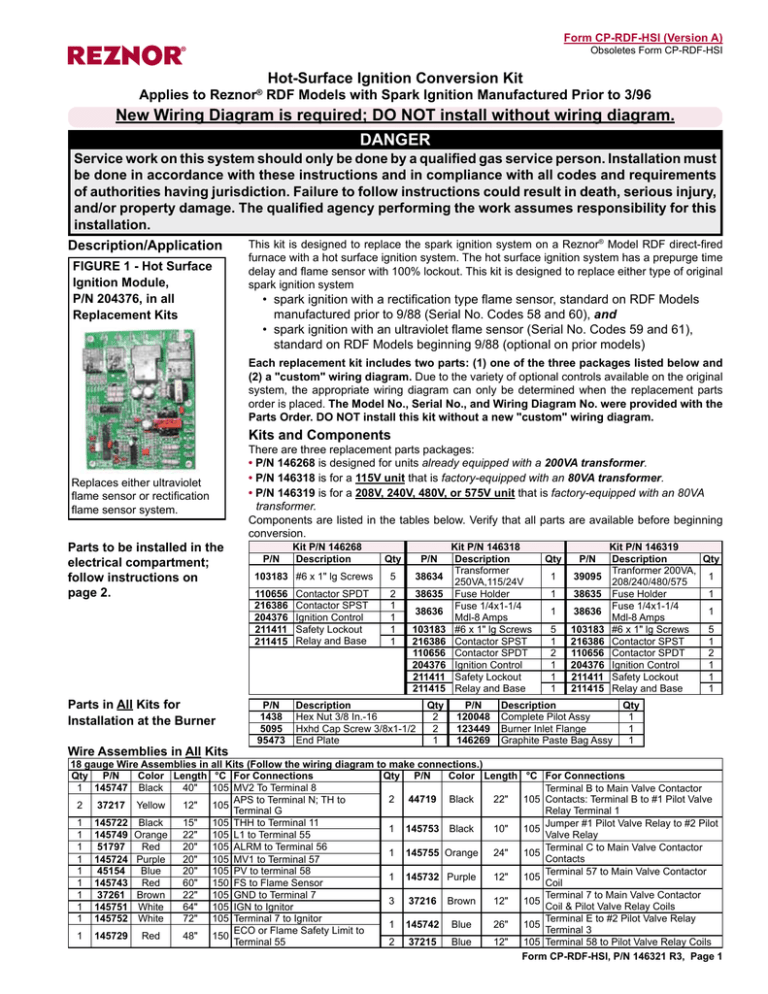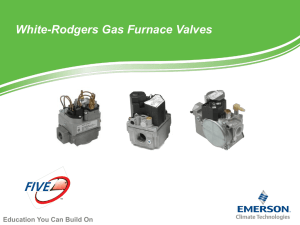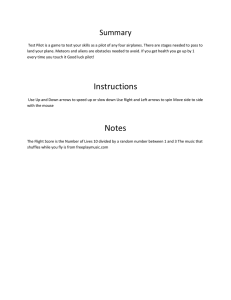
Form CP-RDF-HSI (Version A)
Obsoletes Form CP-RDF-HSI
Hot-Surface Ignition Conversion Kit
Applies to Reznor® RDF Models with Spark Ignition Manufactured Prior to 3/96
New Wiring Diagram is required; DO NOT install without wiring diagram.
DANGER
Service work on this system should only be done by a qualified gas service person. Installation must
be done in accordance with these instructions and in compliance with all codes and requirements
of authorities having jurisdiction. Failure to follow instructions could result in death, serious injury,
and/or property damage. The qualified agency performing the work assumes responsibility for this
installation.
This kit is designed to replace the spark ignition system on a Reznor® Model RDF direct-fired
Description/Application
FIGURE 1 - Hot Surface
Ignition Module,
P/N 204376, in all
Replacement Kits
furnace with a hot surface ignition system. The hot surface ignition system has a prepurge time
delay and flame sensor with 100% lockout. This kit is designed to replace either type of original
spark ignition system
• spark ignition with a rectification type flame sensor, standard on RDF Models
manufactured prior to 9/88 (Serial No. Codes 58 and 60), and
• spark ignition with an ultraviolet flame sensor (Serial No. Codes 59 and 61),
standard on RDF Models beginning 9/88 (optional on prior models)
Each replacement kit includes two parts: (1) one of the three packages listed below and
(2) a "custom" wiring diagram. Due to the variety of optional controls available on the original
system, the appropriate wiring diagram can only be determined when the replacement parts
order is placed. The Model No., Serial No., and Wiring Diagram No. were provided with the
Parts Order. DO NOT install this kit without a new "custom" wiring diagram.
Kits and Components
Replaces either ultraviolet
flame sensor or rectification
flame sensor system.
Parts to be installed in the
electrical compartment;
follow instructions on
page 2.
Parts in All Kits for
Installation at the Burner
Wire Assemblies in All Kits
There are three replacement parts packages:
• P/N 146268 is designed for units already equipped with a 200VA transformer.
• P/N 146318 is for a 115V unit that is factory-equipped with an 80VA transformer.
• P/N 146319 is for a 208V, 240V, 480V, or 575V unit that is factory-equipped with an 80VA transformer.
Components are listed in the tables below. Verify that all parts are available before beginning
conversion.
P/N
Kit P/N 146268
Description
Qty
P/N
103183 #6 x 1" lg Screws
5
38634
110656
216386
204376
211411
211415
Contactor SPDT
Contactor SPST
Ignition Control
Safety Lockout
Relay and Base
2
1
1
1
1
P/N
1438
5095
95473
Description
Hex Nut 3/8 In.-16
Hxhd Cap Screw 3/8x1-1/2
End Plate
38635
38636
103183
216386
110656
204376
211411
211415
Qty
2
2
1
Kit P/N 146318
Description
Transformer
250VA,115/24V
Fuse Holder
Fuse 1/4x1-1/4
Mdl-8 Amps
#6 x 1" lg Screws
Contactor SPST
Contactor SPDT
Ignition Control
Safety Lockout
Relay and Base
P/N
120048
123449
146269
Qty
P/N
1
39095
1
38635
1
38636
5
1
2
1
1
1
103183
216386
110656
204376
211411
211415
Kit P/N 146319
Description
Qty
Tranformer 200VA,
1
208/240/480/575
Fuse Holder
1
Fuse 1/4x1-1/4
1
Mdl-8 Amps
#6 x 1" lg Screws
5
Contactor SPST
1
Contactor SPDT
2
Ignition Control
1
1
Safety Lockout
Relay and Base
1
Description
Complete Pilot Assy
Burner Inlet Flange
Graphite Paste Bag Assy
18 gauge Wire Assemblies in all Kits (Follow the wiring diagram to make connections.)
Qty P/N
Color Length °C For Connections
Qty P/N
Color Length
1 145747 Black
40" 105 MV2 To Terminal 8
2 44719 Black
22"
APS to Terminal N; TH to
2 37217 Yellow
12" 105
Terminal G
1 145722 Black
15" 105 THH to Terminal 11
1 145753 Black
10"
1 145749 Orange
22" 105 L1 to Terminal 55
1 51797
Red
20" 105 ALRM to Terminal 56
1 145755 Orange
24"
1 145724 Purple
20" 105 MV1 to Terminal 57
1 45154
Blue
20" 105 PV to terminal 58
1 145732 Purple
12"
1 145743 Red
60" 150 FS to Flame Sensor
1 37261 Brown
22" 105 GND to Terminal 7
3 37216 Brown
12"
1 145751 White
64" 105 IGN to Ignitor
1 145752 White
72" 105 Terminal 7 to Ignitor
1 145742 Blue
26"
ECO or Flame Safety Limit to
1 145729 Red
48" 150
Terminal 55
2 37215
Blue
12"
Qty
1
1
1
°C For Connections
Terminal B to Main Valve Contactor
105 Contacts: Terminal B to #1 Pilot Valve
Relay Terminal 1
Jumper #1 Pilot Valve Relay to #2 Pilot
105
Valve Relay
Terminal C to Main Valve Contactor
105
Contacts
Terminal 57 to Main Valve Contactor
105
Coil
Terminal 7 to Main Valve Contactor
105
Coil & Pilot Valve Relay Coils
Terminal E to #2 Pilot Valve Relay
105
Terminal 3
105 Terminal 58 to Pilot Valve Relay Coils
Form CP-RDF-HSI, P/N 146321 R3, Page 1
FIGURE 2 - General Control
Location Drawing of a Model
RDF1 Electrical Compartment
If the unit has a flame
rectification type flame
sensor Honeywell #R7795,
attach the relay base, P/N
211415, and install the
plugin relay, P/N 211411.
(NOTE: The relay and
base, P/N's 211411 and
211415, are in all kits
but are not used on units
with Honeywell #R890 or
an ultraviolet type flame
sensor).
­
­
­
­
3) Attach the three 24-volt
main and pilot valve relays
(Contactor P/N's 110656
and 216386).
Terminals
across
the top
2) If the unit is equipped
with an 80VA line voltage
transformer, remove it. In
the same location, attach
the 200VA or 250VA
transformer from the
conversion kit.
FIGURE 3 - General Control Location
Drawing of a Model RDF2 or RDF3
Electrical Compartment
1) Locate the flame safety
relay. Disconnect the wires,
remove the relay and
subbase, and discard. In
the same general location
as the flame safety relay,
position the hot surface
ignition module.
On a Model RDF1, position
the module with the
terminals across the top.
On a Model RDF2 or RDF3,
position the terminals to the
left.
Using the five 1"-screws
provided, attach the module.
FIELD-SUPPLIED: New pilot tubing and fittings may be required. These are not included
and must be supplied locally.
1. Turn off the gas and the electric.
2. Remove the burner compartment and the electrical compartment doors.
3A. Install New Components in the Electrical Compartment See FIGURE 2 or 3 and follow
procedures in 1), 2), and 3) on the left.
­
Installation Instructions
­­
Terminals
on the
left
3B. Install New Parts in the Burner Compartment See FIGURE 4 and follow instructions
in Steps 1), 2), 3) and 4) on page 3. Access to the burner can be obtained either through
the burner access panel in the burner compartment or through the end of the system. First,
remove the burner access panel. If the burner cannot be reached easily, remove the mois-
FIGURE 4 Burner
Access
Burner Access Panel
(in the Burner
compartment) -- Remove
panel to service burner.
(NOTE: Controls
may not be the same
as those illustrated.)
Form CP-RDF-HSI, P/N 146321 R3, Page 2
Pilot
Valve
OR,
burner may
be reached
through the
outside air
hood and/
or filter
cabinet
View of Burner through the
end of the unit.
FIGURE 5 - Pilot
Needle Valve
If unit is equipped with
a pilot needle valve,
disconnect and remove it.
FIGURE 6 - Pilot End of
Burner with Ultraviolet
Flame Sensor System
Being Removed
ture eliminators in the air hood and/or the filters to access the burner through the end of the
unit.
1) Check for a pilot needle valve (factory installed on units manufactured beginning 1/91;
could be field-installed on units manufactured before 1/91). See FIGURE 5. If there is a pilot
needle valve, disconnect and remove it.
2) Disconnect the manifold from the burner end plate (at the coupling). Disconnect the pilot
tubing from the pilot.
3) On the pilot end of the burner (See FIGURE 6), remove the cast iron end plate, the
stainless steel end plate (burners larger than 48" do not have a stainless steel end plate),
the flame sensor, and the pilot assembly. Save the screws and nuts that held the end
plate(s) to the burner. Discard all other removed parts.
1 Remove and discard the two
screws holding the cast iron end
plate to the manifold.
4
2 Remove and save the ten
screws (five on each side)
attaching the end plate(s) to the
burner.
3 Remove and discard the flame
sensor -- either the ultraviolet
with wire (illustrated) or the flame
sensor rod and spark plug.
4 Slide the complete end plate
3
assembly (burners larger than
48" have only the cast iron end
plate), including the pilot, away
1
from the burner. Discard the
assembly including pilot wires.
2 View from "burner
side" showing
one of the rows
of nuts attaching
the end plate to
the burner. (Reuse
this hardware.)
4) Install the new burner end plates and pilot assembly; follow the procedure in FIGURE 7.
FIGURE 7 - Burner with the New End
Plates and Hot Surface Pilot
1 Position the stainless steel end plate on the end
of the burner. On both sides of the "V", insert and
attach the top two screws
2 Use the graphite paste, the bolts, and nuts from
the kit to attach the cast iron burner inlet flange. Be
sure to put graphite paste between the metal
plates around the entire burner inlet opening.
Fasten tightly. Wipe off any excess paste.
3 Position the complete pilot assembly as shown
in the illustration. Put graphite paste between
the metal plates. Attach the pilot assembly to the
stainless steel end plate and the burner. Fasten
tightly. Wipe off any excess paste.
4 Attach the pilot tubing to the pilot solenoid valve
(See FIGURE 4) and to the pilot assembly. If the
old tubing and/or connections are too short or
damaged, supply and install new pilot tubing and
connections.
4. Wiring
Stainless
Steel End
Plate
1
6" Burner
Section
Views from the
Burner Side
4
3
Hot Surface
Pilot Assembly
2 Cast Iron Burner
Inlet Flange
(including mounting
plate, pilot, pilot bushing,
ignitor, and flame sensor)
Follow the new wiring diagram in the kit and make the necessary connections at the burner and
in the electrical compartment. The wire lengths are determined for the smallest burner sizes and
may seem excessively long on some systems. Individually wrap and tie the excess wire length
and "store" neatly in the electrical compartment.
A new wiring diagram label is provided. Clean and dry the inside surface of the electrical compartment door panel. Position the label on the door. Carefully peel the backing and adhere the
wiring diagram label to the inside of the door panel.
Form CP-RDF-HSI, P/N 146321 R3, Page 3
Installation Instructions (cont'd)
WARNING
Do not turn on the electric or the gas before reading Section 5, below. Complete all of the start-up/operation
procedures in Section 5 before attempting to operate the system.
5. Start-up and Operation Instructions
1) Close all service panels except the electrical and burner
control compartment doors. If removed, reinstall the
moisture eliminators and/or filters.
2) Check for pilot line leaks.
a. Set the blower and burner switches to "test" position
(switches are in the electrical compartment; see service
switches in FIGURE 2 or 3, page 2). NOTE: This is a
necessary safety procedure in order to override control
from the remote console when electrical power is on at the
disconnect switch.
b. Turn on the electrical power to the system.
c. Immediately upstream from the main burner, close the
manual shutoff valve
d. Turn on the gas supply to the unit; open pilot manual shutoff
and solenoid valve.
e. Using a leak detecting solution, check all connections in the
pilot line. Correct any leaks.
WARNING
Never test for gas leaks with an open flame. Failure to comply could result in severe personal injury, property
damage, or death.
3) Verify pilot gas pressure.
a. Connect a "U" tube manometer to the pressure
tap on the downstream side of the pilot
solenoid valve.
b. With blower in operation, measure pilot
supply pressure. Pilot pressure for natural gas
should be 3.5" w.c.; pilot pressure for propane
gas should be 6" w.c. Pilot pressure should
already be correct; but if the pressure is not
correct, adjust at the pilot regulator. Remove
the cap from the pilot regulator and turn the
adjustment clockwise to increase gas pressure
or counterclockwise to decrease pressure.
c. When pressure is correct, shut off the gas,
remove the manometer, and replace the
pressure test cap on the pilot solenoid valve.
d. Turn on the gas supply.
4) Check the pilot lockout feature.
Turn the manual pilot shutoff valve "off". After
two trials for ignition, the pilot system should
lockout. To reset the unit, open the gas valve
and cycle the main disconnect switch.
5) Restore the system to normal operation.
a. Set the blower and burner service switches to
"off" position.
b. Turn off the electrical power and the gas
supply.
c. Open the manual shutoff valve immediately
upstream from the main burner.
d. Set the blower and burner service switches to
"run" position.
e. Close the electrical and burner compartment
doors.
f. Turn on the electrical power and the gas
supply.
g. Installation of the replacement ignition system
is complete and the unit is restored to normal
control. Test the unit from the remote console
to verify proper operation.
6. Troubleshooting the Hot Surface
Ignition System
Thermostat (TH) closes.
Lockout SLR switched ON. Reset
control by interrupting power
to Terminal TH.
NO
Control self
check OK?
YES
HSI energized.
Is 1.4A OK?
15-second heatup
time maxmum
increment trial register.
Two unsuccessful
tries, then lockout.
NO
YES
Begin 5-second
prepurge.
Ignition trial, 15 seconds.
Pilot valve energized,
Trial #1, #2 (2 maximum).
Main valve 1
energized. Reset
trial register to 0.
YES
Pilot flame
NO
detected? 5 microamps
or greater?
Begin 30-second delay to
OFF (prevents MV1 from
opening for 30 seconds
after TH opens).
10-second
interpurge and increment
trial register. 2nd trial
complete?
NO
YES
THH closes; main
valve 2 switched
ON.
Lockout SLR
switched ON.
NO
Begin 15-second delay
to OFF. (Prevents MV2
from opening for
15 seconds after
THH opens).
Flame sense
OK?
YES
TH or THH opens.
Main valve 2 shuts OFF.
Heating cycle
is complete.
Pilot and Main
Valve 1 OFF
if TH opens.
www.RezSpec.com; (800) 695-1901
Form CP-RDF-HSI, P/N 146321 R3, Page 4
©2014 Reznor, LLC. All rights reserved.
Trademark Notes: Reznor®is registered in at least the United States.
All other trademarks are the property of their respective owners.
0514 Form CP-RDF-HSI (Version A.1)



